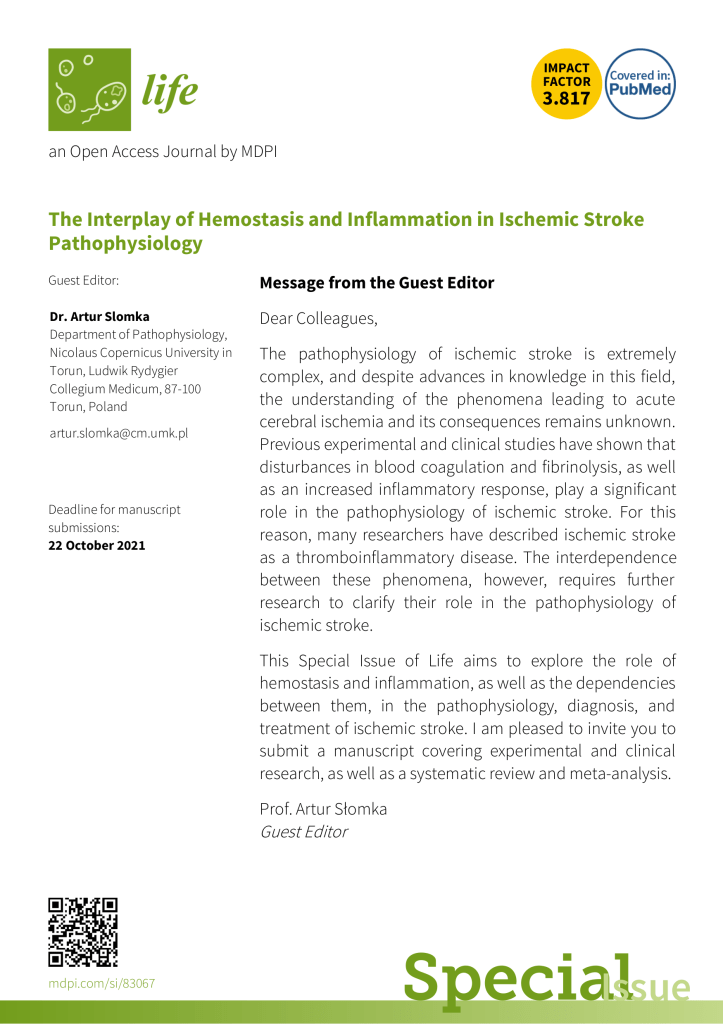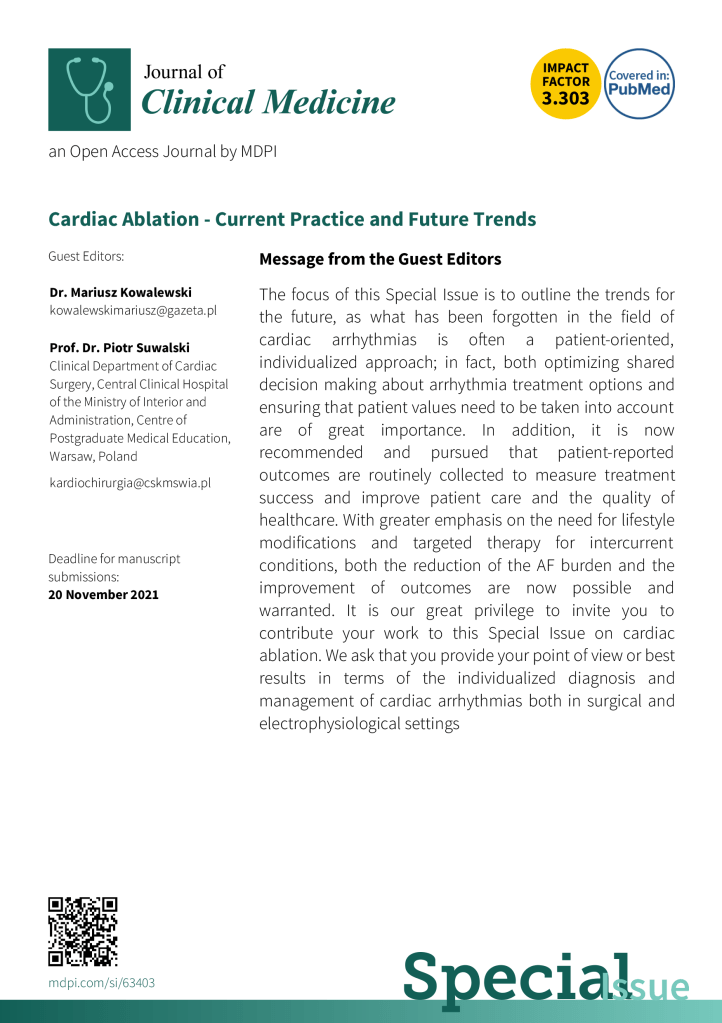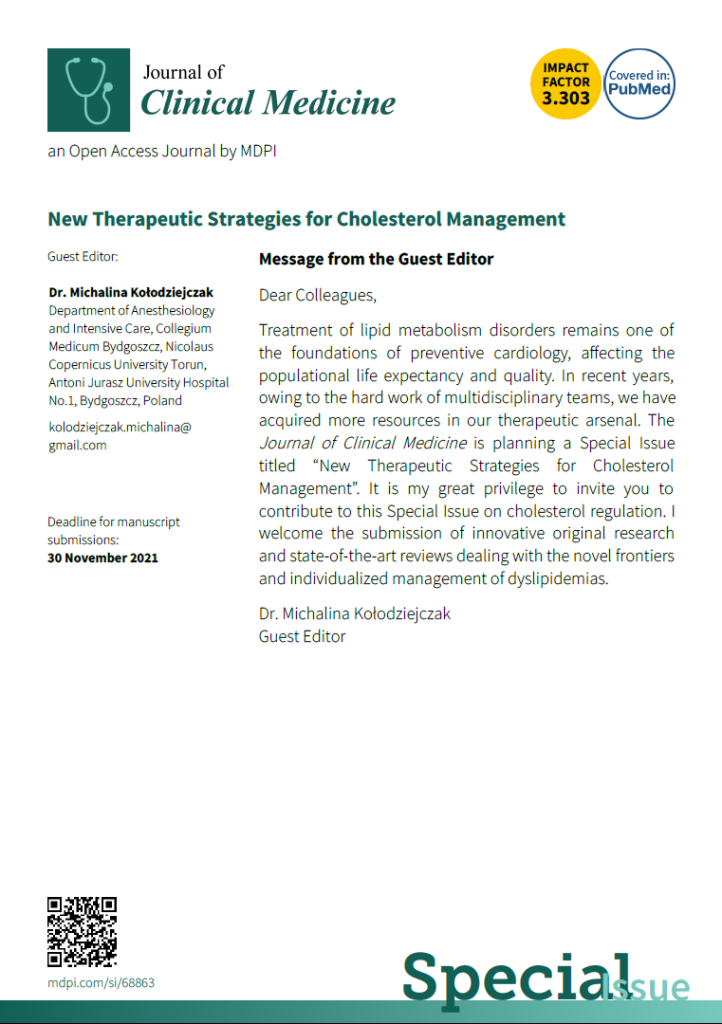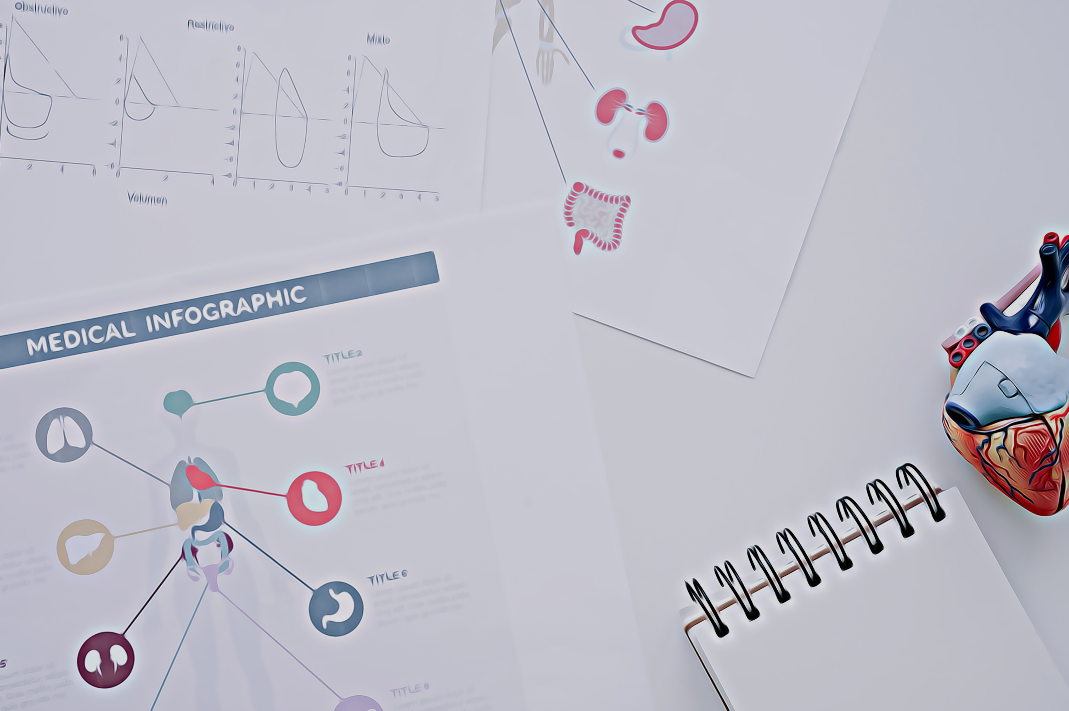
Dear Colleagues,
The pathophysiology of ischemic stroke is extremely complex, and despite advances in knowledge in this field, the understanding of the phenomena leading to acute cerebral ischemia and its consequences remains unknown. Previous experimental and clinical studies have shown that disturbances in blood coagulation and fibrinolysis, as well as an increased inflammatory response, play a significant role in the pathophysiology of ischemic stroke. For this reason, many researchers have described ischemic stroke as a thromboinflammatory disease. The interdependence between these phenomena, however, requires further research to clarify their role in the pathophysiology of ischemic stroke. Moreover, the relationship between these processes, the patient’s outcomes, and the effectiveness of the therapy used remains a mystery.
This Special Issue of Life aims to explore the role of hemostasis and inflammation, as well as the dependencies between them, in the pathophysiology, diagnosis, and treatment of ischemic stroke. I am pleased to invite you to submit a manuscript covering experimental and clinical research, as well as a systematic review and meta-analysis.
Prof. Artur Słomka
Guest Editor

Dear Colleagues,
Cardiac arrhythmias and, in particular, atrial fibrillation (AF), have become a burden in today’s aging society, and are often associated with numerous other comorbidities. While largely impacting heart function and quality of life, at the same time, the loss of proper cardiac contractility heralds the risk of systemic thromboembolism and stroke. On the positive side, new treatments are emerging for rhythm control, rate control and stroke prevention. Together with recent advancements in surgical and catheter ablation, we now have what seems to be a wide arumentarium to face rhythm disturbances. As also reflected in the recent 2020 ESC guidelines, cardiac ablation has gained higher recognition and its class of indication has been moved from IIa to I in many clinical scenarios.
The focus of this Special Issue is to outline the trends for the future, as what has been forgotten in the field of cardiac arrhythmias is often a patient-oriented, individualized approach; in fact, both optimizing shared decision making about arrhythmia treatment options and ensuring that patient values need to be taken into account are of great importance. In addition, it is now recommended and pursued that patient-reported outcomes are routinely collected to measure treatment success and improve patient care and the quality of healthcare. With greater emphasis on the need for lifestyle modifications and targeted therapy for intercurrent conditions, both the reduction of the AF burden and the improvement of outcomes are now possible and warranted.
It is our great privilege to invite you to contribute your work to this Special Issue on cardiac ablation. We ask that you provide your point of view or best results in terms of the individualized diagnosis and management of cardiac arrhythmias both in surgical and electrophysiological settings.
Dr. Mariusz Kowalewski
Prof. Dr. Piotr Suwalski
Guest Editors

Dear Colleagues,
Treatment of lipid metabolism disorders remains one of the foundations of preventive cardiology, affecting the populational life expectancy and quality. In recent years, owing to the hard work of multidisciplinary teams, we have acquired more resources in our therapeutic arsenal. Additionally, the entire spectrum of scientific research methodologies, including genetic studies, prospective epidemiologic cohort studies, Mendelian randomisation studies, and randomised trials of LDL-C lowering therapies, provided further insights to the impact of lipid profile on the burden of atherosclerotic disease and directly influenced the dynamic development of new therapeutic standards. With those advancements, as reflected in the current ESC 2019 guideline recommendations, patients at high and very high cardiovascular risk should now achieve more restrictive than ever before LDL-C treatment goals (≥50% reduction from baseline and <1.8 mmol/L [<70mg/dL]). On the other hand, many researchers also pursue the early introduction of dyslipidemia management in low-risk populations to reduce the LDL-C exposure and the concomitant atherosclerotic cardiovascular disease burden.
It is my great privilege to invite you to contribute to this Special Issue on cholesterol regulation. I welcome the submission of innovative original research, state-of-the-art reviews, and viewpoints dealing with the novel frontiers and individualized management of dyslipidemias
Dr. Michalina Kołodziejczak
Guest Editor
Manuscript Submission Information
Manuscripts should be submitted online at www.mdpi.com by registering and logging in to this website. Once you are registered, click here to go to the submission form. Manuscripts can be submitted until the deadline. All papers will be peer-reviewed. Accepted papers will be published continuously in the journal (as soon as accepted) and will be listed together on the special issue website. Research articles, review articles as well as short communications are invited. For planned papers, a title and short abstract (about 100 words) can be sent to the Editorial Office for announcement on this website.
Submitted manuscripts should not have been published previously, nor be under consideration for publication elsewhere (except conference proceedings papers). All manuscripts are thoroughly refereed through a single-blind peer-review process. A guide for authors and other relevant information for submission of manuscripts is available on the Instructions for Authors page. Journal of Clinical Medicine is an international peer-reviewed open access semimonthly journal published by MDPI.
Please visit the Instructions for Authors page before submitting a manuscript. The Article Processing Charge (APC) for publication in this open access journal is 2200 CHF (Swiss Francs). Submitted papers should be well formatted and use good English. Authors may use MDPI’s English editing service prior to publication or during author revisions.
